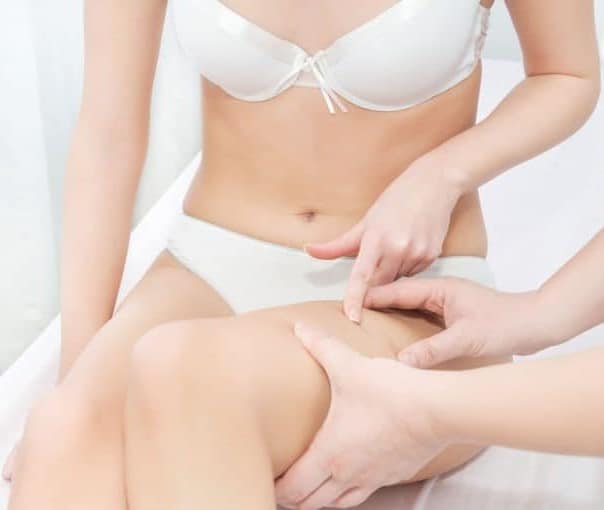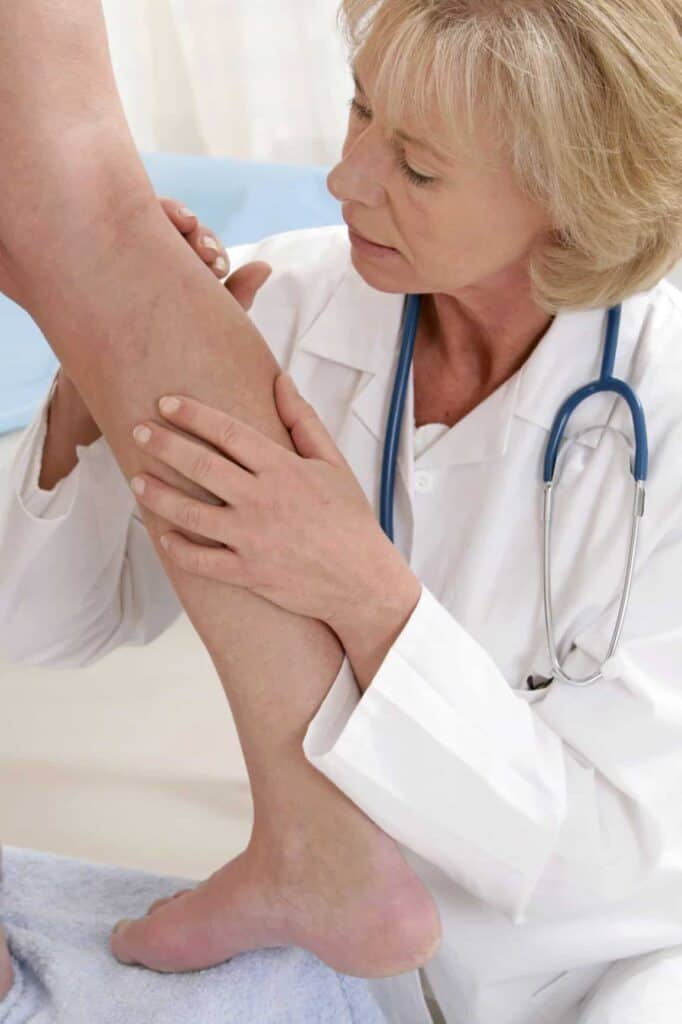
IPL treatment for Spider Veins
IPL treatment, known as Intense Pulsed Light therapy, uses a non-laser, high-intensity light source to help reduce and heal spider veins as well as other skin blemishes and problems. IPL therapy damages the walls of your blood vessels with heat. This application of heat causes the spider veins walls to weaken and then vanish over the next several weeks. IPL works best on 1mm or smaller vessels close to the surface of the skin.
In many regards, IPL treatment is like laser treatment therapy. The major difference is that the light isn’t focused with IPL. This has its advantages. The procedure offers the benefit of being more speedy than laser. Since the light isn’t as focused as the laser, it can cover a wider area (up to almost a half inch per pulse.) The light is not as precise as it is with a laser nor is it set at a particular wavelength. As with laser treatment, you will likely need more than one treatment before seeing the full benefits of the IPL.

What are the risks of IPL therapy?
Laser and IPL therapy may not be suitable for everyone. Sometimes, patients with tanned or darker skin tones have additional complications. The increased amount of pigmentation (melanin) in darker skin tones has the increased potential to absorb the energy from the laser or light, causing permanent discoloration. In cases where patients do experience some discoloration, their normal skin color usually returns in 4 to 6 months after treatment.
When completed by an experienced physician, your risk of side effects decrease, however when handled by an untrained user, IPL treatment may lead to patchy darkened areas of skin. There is a small risk that skin treated with a laser can become very thin, leading to ulceration in very rare cases.
What does IPL Treatment cost?
Treatments for spider veins (whether they be Laser or IPL) are generally considered cosmetic and not medical. Therefore they are not covered by medical insurance. The cost of the different procedures vary depending on:
- which method is used to treat the condition,
- the number of veins being treated,
- the size of the veins,
- how large of an area is being treated
- the number of follow-up treatments that are needed.

Zap Away your Spider Veins
IPL therapy is an exciting new procedure in the field of spider vein treatment. Light therapy safely uses light energy to erase painful and unsightly veins. The therapeutic method is 100% toxin-free and non-invasive, giving you great results without the risks or down-time that comes with other forms of treatment.
What are the common reasons for IPL treatment for spider veins to fail or be less effective?
Several factors can cause IPL (Intense Pulsed Light) treatment for spider veins to be less effective or to fail. Understanding these reasons can help you better prepare for the treatment and discuss potential issues with your healthcare provider:
- Incorrect Settings: If the IPL device settings are not properly adjusted for your skin type and vein characteristics, the treatment may be ineffective.
- Inadequate Treatment Sessions: Some patients may require more sessions than initially planned to achieve desired results. Incomplete treatment courses can lead to suboptimal outcomes.
- Skin Type and Tone: IPL may be less effective on darker skin tones due to the risk of pigmentation changes and difficulty in targeting veins without affecting surrounding skin.
- Vein Size and Depth: IPL is typically more effective on smaller, superficial spider veins. Larger or deeper veins may not respond well to this treatment.
How effective is IPL treatment for spider veins on darker skin tones?
IPL (Intense Pulsed Light) treatment can be challenging for individuals with darker skin tones due to the higher melanin content in their skin. Here are some considerations regarding its effectiveness and safety:
Effectiveness:
1. Risk of Pigmentation Changes:
– Darker skin tones have more melanin, which can absorb the light energy from IPL. This can lead to hyperpigmentation (dark spots) or hypopigmentation (light spots) if not properly managed.
2. Settings Adjustment:
– IPL devices need to be carefully calibrated to lower energy levels to minimize the risk of damaging the skin. This can make the treatment less effective for spider veins because the energy may not be strong enough to target the veins adequately.
3. Targeted Treatment:
– IPL is more effective on lighter skin tones because the contrast between the skin and the veins is greater, allowing the light to better target the veins without affecting the surrounding skin.
Are there any post-treatment care instructions to follow after IPL treatment?
After IPL (Intense Pulsed Light) treatment for spider veins, it’s important to follow post-treatment care instructions to optimize results and ensure proper healing. Here are some common post-treatment care instructions that may be recommended:
- Avoid exposure to direct sunlight: Protect the treated area from direct sunlight for a few weeks following IPL treatment. Use sunscreen with a high SPF (sun protection factor) to shield the skin from harmful UV rays.
- Maintain skin hygiene: Keep the treated area clean and avoid harsh scrubbing or exfoliation for a few days. Gently cleanse the skin with mild soap or a gentle cleanser.
- Avoid hot baths and showers: Refrain from hot baths, hot tubs, saunas, or steam rooms for a few days after treatment, as the heat can potentially irritate the skin.
- Avoid excessive heat: Minimize exposure to heat sources such as hot compresses, heating pads, or heated styling tools in the treated area.
- Avoid strenuous exercise: Refrain from vigorous exercise or activities that may cause excessive sweating for a couple of days after treatment.
- Protect the treated area: If necessary, cover the treated area with loose clothing or a bandage to protect it from friction or irritation.
- Moisturize the skin: Apply a gentle moisturizer to keep the treated skin hydrated and help promote healing.
Who is a good candidate for IPL treatment for spider veins?
Good candidates for IPL (Intense Pulsed Light) treatment for spider veins are individuals who have visible spider veins on their face or body and are looking for a non-invasive solution. The ideal candidate should have a generally good health condition, realistic expectations, and understand the potential outcomes of the treatment. IPL treatment works best for people with fair to light skin tones, as darker skin may be more prone to pigmentation changes.
Does IPL Treatment Cause Burns Or Skin Damage?
Unfortunately yes, there are chances of IPL treatment causing you burns or skin damage. Luckily, it’s quite rare, especially if your treatment is done by an experienced and qualified professional. However, even if burns happen, it might be because the device’s settings aren’t properly matched with patient’s skin type, condition or sensitivity. Also, there are some more factors that might lead to burns or skin damage, some of these are tanned skin, improper preparation, or using the treatment on sensitive skin.
If the burns happen, they can lead to issues like redness, blisters, or changes in skin pigmentation. At least you can still avoid all these complications by follow all the pre-procedure tips, explaining your doctor about your skin and talking about your skin type!
Is IPL Treatment Painful?
No, it is generally not considered a painful treatment, but people with sensitive skin can experience some mild discomfort. Even if you experience any pain, it will feel like spanning or stinging sensation like a rubber band hitting your skin. But it also depends on your pain tolerance, the area being treated and skin’s sensitivity.
How Long IPL Results Last? Are Touch-ups Necessary?
Usually the results of IPL can last from several months to few years, depending on the condition you are getting treated, your skin type and lifestyle factors. If you are getting IPL fir problems like pigmentation, redness, or sun damage their you can expect long-lasting results, especially if you do a good skincare afterwards. While for cases like hair removal, it’s not completely permanent, and you might need to have touchups every 6-12 months. Some treatments might need regular maintenance, while some will depend on how often they are needed. Your doctor will always inform you about the maintenances though, so you don’t need to worry!
Spider Veins FAQs
Spider veins are swollen or enlarged veins that are visible through the skin because of their blue or red color. They get their name from their spider appearance. When the veins become dilated they twist and turn like the gnarled branches of a tree. Depending on the seriousness of spider veins, these blue lines can extend the length of the legs, around the ankles and down to the heels. Because they are highly visible, spider veins are often a source of embarrassment and decreased confidence.
Spider veins are not dangerous; however, they can result in discomfort, pain, itching and swelling. They can sometimes be accompanied by a rash.
Spider veins can decrease your confidence and quality of life.
Both spider veins and varicose veins occur when weak or damaged valves in your veins can no longer effectively pump blood back to your heart. They most commonly appear in the lower extremities of the body because the valves can no longer compete with the force of gravity.
The blood will pool in the legs instead of being pumped back up to the heart. Spider veins can appear in other areas, like the shoulders or face. As more and more blood pools in an area, the veins are more visible through the skin.
Studies show that 30% to 60% of adults suffer from either varicose veins or spider veins. Genetics can play a role in spider veins. If someone in your family has them, you may develop them too. Other factors include gender, age, weight, underlying medical conditions, and a past history of blood clots.
If, because of your job or other regular activity, you spend a lot of time on your feet, you are more likely to develop spider veins. Teachers, hair stylists, restaurant and factory workers are vulnerable to spider and varicose veins.
Women are slightly more likely to get spider veins than men. According to research, one in three women have spider veins while one in four suffer from varicose veins. Older people are more likely to have them than younger people. If you’ve suffered from injuries in the legs, previously had vein surgery, or have been exposed to a lot of sunlight during your lifetime, you have an elevated risk for developing spider veins.
Come in for your Free Consultation at The Advanced Vein Center
